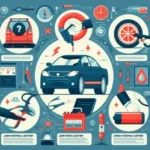As the sun rises over the horizon and the open road beckons, the promise of adventure awaits those ready to embark on a road trip.
However, before you pack your bags and hit the highway, it’s crucial to ensure that your vehicle is road-ready. Car maintenance is the unsung hero of any successful journey, playing a vital role in your safety, comfort, and overall experience. From checking tire pressure to inspecting fluid levels, each step in this maintenance checklist can mean the difference between a smooth ride and an unexpected roadside breakdown. In this ultimate guide to car maintenance, we’ll equip you with essential tips and tricks to prepare your car for the journey ahead, ensuring that your only concern is which scenic route to take next. Get ready to rev up your engine and explore the open road with confidence!
1. Introduction: Why Car Maintenance Matters for Road Trips
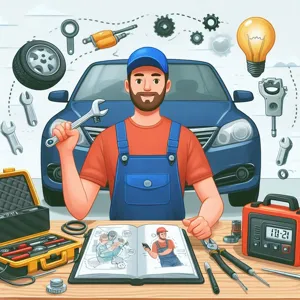
Embarking on a road trip is often synonymous with freedom and adventure, offering the thrill of open roads and the allure of spontaneous detours. However, the excitement of hitting the highway can quickly turn into a nightmare if your vehicle isn’t in prime condition. This is where the importance of car maintenance comes into play. Proper upkeep of your vehicle not only ensures a smoother ride but also significantly reduces the risk of unexpected breakdowns, allowing you to focus on the journey rather than the mechanics.
Imagine cruising along scenic routes, the wind in your hair, and your favorite playlist filling the air—only to be interrupted by the ominous sound of a sputtering engine. Regular maintenance is your ticket to avoiding such scenarios. By performing essential checks and repairs before setting out, you can enhance your vehicle’s reliability and performance, ensuring it can handle the demands of long-distance travel.
Moreover, a well-maintained car contributes to your safety and the safety of your passengers. Flat tires, faulty brakes, and overheating engines are all preventable issues that can arise from neglecting routine maintenance. Prioritizing your vehicle’s health not only protects your investment but also provides peace of mind, allowing you to explore with confidence.
In this guide, we’ll delve into the critical aspects of car maintenance that are vital for a successful road trip. From essential pre-trip inspections to ongoing care during your travels, we’ll equip you with the knowledge you need to ensure your vehicle is ready for the adventure ahead. Buckle up, and let’s get started on the journey to a smooth and enjoyable road trip experience!
2. Preparing Your Vehicle: A Pre-Trip Checklist
Before hitting the open road for your much-anticipated adventure, taking the time to meticulously prepare your vehicle is crucial for a smooth and enjoyable journey. A pre-trip checklist acts as your roadmap to ensuring that every aspect of your car is ready to tackle the miles ahead. Here’s what you should include in your preparation process:
**1. Inspect the Fluids:** Start by checking your oil, coolant, brake fluid, transmission fluid, and windshield washer fluid. Low or dirty fluids can hinder your vehicle’s performance, potentially leading to costly repairs on the road. If necessary, top them off or schedule an oil change before your trip.
**2. Check the Tires:** Your tires are your car’s only contact with the road, so they must be in optimal condition. Inspect them for adequate tread depth and ensure they are properly inflated. Don’t forget to check the spare tire as well! Remember, a flat tire can quickly derail your travel plans.
**3. Test the Brakes:** Ensuring your braking system is functioning properly is vital for safety. Listen for any unusual sounds when braking and feel for any vibrations. If anything seems off, have a professional inspect your brakes to avoid potential hazards on your journey.
**4. Ensure Lights and Signals Work:** Check all your vehicle’s lights, including headlights, brake lights, turn signals, and hazard lights. Proper visibility is essential, especially if you plan to drive during the evening or in poor weather conditions.
**5. Review the Battery:** A dead battery can put a damper on your road trip before it even begins. Inspect the battery terminals for corrosion and ensure that it is securely fastened. If your battery is older than three years, consider having it tested to prevent unexpected failures.
**6. Prepare Emergency Supplies:** Equip your vehicle with essential emergency supplies, including a first-aid kit, flashlight, basic tools, jumper cables, and a spare tire kit. These items can be invaluable if you encounter an unexpected breakdown or roadside emergency.
**7. Clean and Organize the Interior:** A clutter-free space not only creates a more comfortable driving environment but also allows you to find essential items quickly. remove any unnecessary items, vacuum the interior, and ensure that all necessary travel documents, like your license and registration, are easily accessible.
By carefully working through this pre-trip checklist, you can rest assured that your vehicle is in peak condition, allowing you to focus on the excitement of your road trip. With your car prepared for the adventure ahead, you’re one step closer to making unforgettable memories on the open road!
3. Checking Your Fluids: Oil, Coolant, and More
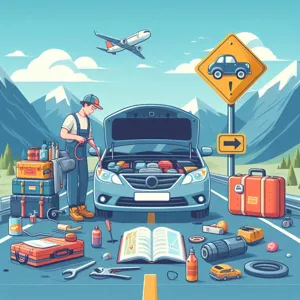
Before hitting the open road, one of the most crucial steps in preparing your vehicle for a smooth road trip adventure is to check your fluids. This might seem like a mundane task, but ensuring that your oil, coolant, and other vital fluids are at optimal levels can mean the difference between a carefree journey and a roadside emergency.
**Oil:** Start by checking your engine oil. This lubricant is essential for keeping your engine running smoothly, reducing friction, and preventing overheating. To check the oil level, simply pull out the dipstick, wipe it clean, reinsert it, and then pull it out again to see where the oil line falls. If it’s low, top it off with the recommended oil for your vehicle. Additionally, consider the oil’s color and consistency; if it’s dark and gritty, it may be time for an oil change.
**Coolant:** Next, turn your attention to the coolant. This fluid is vital for regulating your engine’s temperature and preventing overheating, especially during long drives in warm weather. Check the coolant reservoir for the appropriate level—ideally, it should be between the “low” and “full” marks. If it’s low, you can top it off with a mixture of antifreeze and distilled water, ensuring that you’re using the right type for your vehicle. Remember, never open the radiator cap while the engine is hot, as it can release steam and cause burns.
**Other Fluids:** Don’t forget about other essential fluids, such as brake fluid, transmission fluid, power steering fluid, and windshield washer fluid. Each plays a unique role in your vehicle’s operation. Brake fluid ensures your brakes function effectively, transmission fluid keeps your gears shifting smoothly, power steering fluid helps with maneuverability, and windshield washer fluid keeps your visibility clear. Check each of these fluids and top them off as necessary.
By taking the time to check and maintain your vehicle’s fluids before your road trip, you not only enhance your car’s performance but also secure peace of mind. Knowing that your vehicle is in top shape allows you to focus on the journey ahead, creating lasting memories without the worry of unexpected breakdowns. So grab your tools and give your fluids a thorough check—it’s a small step that promises a big payoff on the open road!
4. Tire Care: Pressure, Tread Depth, and Rotation
When it comes to ensuring a smooth and safe road trip, tire care is paramount. Your tires are the only point of contact between your vehicle and the road, making their condition critical not only for performance but also for safety. Let’s break down the essential components of tire care: pressure, tread depth, and rotation.
**Pressure:** Maintaining the correct tire pressure is crucial for optimal performance and fuel efficiency. Under-inflated tires can lead to sluggish handling and increased fuel consumption, while over-inflated tires may wear unevenly and increase the risk of a blowout. To find the recommended pressure for your tires, check the sticker located on the driver’s side door jamb or consult your vehicle’s owner manual. Before hitting the road, invest a few minutes to use a tire pressure gauge to check each tire’s pressure, including the spare. Ensure they are inflated to the recommended levels, adjusting as necessary.
**Tread Depth:** The tread on your tires provides the necessary grip and traction needed for safe driving, especially in wet or slippery conditions. As your tires wear down, the tread depth decreases, increasing the likelihood of hydroplaning or losing control. A simple way to check tread depth is to use the penny test: insert a penny into the tread grooves with Lincoln’s head facing down. If you can see the top of his head, it’s time to replace your tires. For optimal safety on your road trip, aim for a minimum tread depth of 2/32 of an inch.
**Rotation:** Tire rotation is the practice of moving your tires from one position to another on your vehicle at regular intervals. This helps to ensure even tire wear, prolonging the life of your tires and improving handling. Most experts recommend rotating your tires every 5,000 to 7,500 miles or as indicated in your vehicle’s maintenance schedule. By keeping your tires evenly worn, you not only enhance your vehicle’s performance but also contribute to a smoother, more comfortable ride during your adventure.
By paying attention to these key aspects of tire care, you’ll be better equipped to handle any road conditions that come your way. A little diligence in maintaining your tires can translate to a safer, more enjoyable road trip experience, allowing you to focus on the journey ahead rather than worrying about unexpected breakdowns. Remember, a well-maintained vehicle is the first step to an unforgettable road trip adventure!
5. Brake System Inspection: Ensuring Safety on the Road
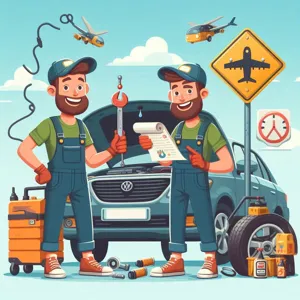
When preparing for a road trip, one of the most critical aspects of car maintenance often overlooked is the brake system inspection. Your brakes are your vehicle’s primary safety feature, and ensuring they are in optimal condition can mean the difference between a smooth journey and a potential disaster.
Start by checking the brake pads for wear and tear. If the pads are too thin, they may not provide adequate stopping power, especially on long descents or during sudden stops. A good rule of thumb is to replace them when they have about a quarter-inch of material left—any less, and you risk damaging the rotors, which can lead to costly repairs down the line.
Next, inspect the brake fluid. Low fluid levels can indicate a leak in the system, while dirty fluid can compromise braking efficiency. Brake fluid should be clear or slightly yellow; if it appears dark or gritty, it’s time for a flush. Don’t forget to check the brake lines and hoses for any signs of wear, cracks, or leaks, as these can also jeopardize your safety.
Finally, listen for any unusual sounds when applying the brakes—squeaking, grinding, or a pulsating feel can all signal underlying issues that need addressing before hitting the road. A thorough brake system inspection not only enhances your safety but also provides peace of mind, allowing you to enjoy the open road ahead. After all, the last thing you want on a road trip is to worry about your vehicle’s ability to stop when it matters most. So, before you embark on your adventure, make sure your brakes are ready to handle whatever the journey throws your way.
6. Battery Health: Tips for a Reliable Start
Battery health is a critical component of any successful road trip, as a reliable start is paramount to enjoying your journey. There’s nothing more frustrating than turning the key in the ignition and hearing that dreaded click instead of a smooth engine roar. To ensure your battery is up for the adventure ahead, follow these essential tips.
First, regularly check the battery terminals for corrosion, which can hinder electrical connections. A simple cleaning with a mixture of baking soda and water can do wonders for maintaining a solid link between the terminals and the battery. Make sure to wear gloves and eye protection while doing this, as the process can sometimes release harmful gases.
Next, it’s advisable to test your battery’s voltage regularly, especially if it’s older than three years. Many auto parts stores offer free battery testing, or you can invest in a multimeter to monitor its health at home. A fully charged battery should read around 12.6 volts or more, while anything below 12.4 volts indicates it’s time to recharge or replace the battery altogether.
Temperature fluctuations can also impact battery performance. If you’re embarking on a journey through hot or cold climates, be aware that extreme temperatures can reduce battery efficiency. If you’re heading into particularly sweltering conditions, consider using a battery insulation blanket to protect it from excessive heat. Conversely, for colder climates, make sure the battery is fully charged, as cold weather can diminish its capacity.
Lastly, always keep jumper cables in your car, just in case. Even with all precautions taken, unexpected situations can arise, and having a reliable set of jumper cables can be a lifesaver. Consider practicing how to jump-start a vehicle before you hit the road, so you’re prepared for any battery-related issues that may occur during your adventure.
By prioritizing battery health and following these tips, you can ensure that your vehicle starts reliably, allowing you to focus on the journey ahead and make the most of your road trip experience. Safe travels!
7. Lights and Signals: Visibility and Communication on the Road
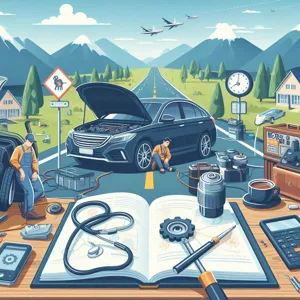
When it comes to a smooth road trip adventure, ensuring your vehicle’s lights and signals are in top condition is paramount. Visibility is not just about seeing the road; it’s about being seen by others. Before embarking on your journey, take the time to inspect all your vehicle’s lighting systems, including headlights, taillights, brake lights, and turn signals. A simple walk-around inspection can reveal burnt-out bulbs or hazy lenses that could reduce your visibility, especially during twilight or inclement weather.
Headlights are your primary source of illumination, so it’s crucial to make sure they are bright and properly aligned. Misaligned headlights can blind oncoming drivers or fail to adequately light the road ahead. Consider upgrading to LED or high-intensity discharge (HID) bulbs for improved brightness and longevity. Don’t forget about your fog lights, too; they can be a lifesaver when driving through fog, rain, or snow.
Equally important are your turn signals and brake lights. These lights are essential for communication with other drivers. A malfunctioning turn signal can lead to confusion and increase the risk of accidents. Regularly check that all indicators flash brightly and at the correct rate. If your vehicle is equipped with running lights, ensure they also function properly, as they enhance your vehicle’s visibility to others on the road.
Lastly, consider the impact of cleanliness on visibility. Dirty headlights can significantly impair the light output, so make sure to clean them regularly. A quick wash can make a world of difference, not just for headlights but for all exterior lights as well.
By making visibility and communication a priority before your road trip, you not only ensure your safety but also enhance the overall experience. After all, a smooth journey begins with a well-prepared vehicle, ready to light up the roads and signal your intentions with clarity.
8. Wiper Blades and Windshield Care: Clear Vision Ahead
When embarking on a road trip, having a clear vision ahead is paramount, and this begins with your wiper blades and windshield care. Often overlooked, these components are your first line of defense against rain, dirt, and debris that can obstruct your view while driving.
Start by assessing the condition of your wiper blades. If you notice streaks, skips, or an inability to adequately clear water from your windshield, it’s time for a replacement. Wiper blades should be replaced approximately every six months, or sooner if you live in an area with extreme weather conditions. Invest in high-quality blades that are designed for your specific vehicle; they’ll perform better and last longer.
Next, don’t forget about your windshield itself. Regularly cleaning it will not only enhance visibility but also prolong the life of your wiper blades. Use a glass cleaner that’s safe for automotive use, and consider a microfiber cloth to avoid scratching the surface. For added protection, a hydrophobic windshield treatment can be applied, repelling water and making it much easier to see in rain.
Lastly, check the windshield washer fluid. Fill it up with a suitable cleaning solution—especially one that combats bugs and road grime. Ensure that the washer jets are functioning properly; nothing is worse than being caught in a downpour with inadequate visibility and an empty washer fluid reservoir.
By taking the time to ensure your wiper blades and windshield are in top shape, you’ll enjoy a clearer view of the open road ahead, allowing you to focus on the adventure instead of the obstacles. With clear vision, you can navigate through varying weather conditions confidently, making your road trip not just a journey, but a safe and enjoyable experience.
9. Air Filter and HVAC System: Comfort During Your Journey
When embarking on a road trip adventure, comfort is key, and that’s where the air filter and HVAC (Heating, Ventilation, and Air Conditioning) system come into play. A clean air filter ensures that the air circulating in your vehicle is fresh and free from pollutants, dust, and allergens, creating a pleasant environment for everyone on board. Neglecting this simple yet vital component can lead to unpleasant odors, reduced air quality, and increased strain on your HVAC system, which ultimately affects its performance.
Before hitting the road, take a moment to inspect your air filter. A clogged or dirty filter can restrict airflow, making your HVAC system work overtime to maintain a comfortable temperature. This not only diminishes your comfort but can also lead to higher fuel consumption—a consideration that’s especially important when you’re planning an extended journey. Most manufacturers recommend checking or replacing the air filter every 12,000 to 15,000 miles, but your driving environment can dictate the frequency. If you often drive in dusty or polluted areas, you may need to do it more regularly.
In addition to the air filter, ensure that your HVAC system is functioning optimally. Check the coolant levels and make sure there are no leaks in the system. A well-maintained HVAC not only provides temperature control but also helps to defog your windows and improve visibility, which is crucial for safe driving. Consider performing a quick test of the system: turn on the air conditioning and heater to ensure they are operating as expected.
For those long stretches of highway or winding country roads, having a comfortable cabin environment makes all the difference. Whether it’s a refreshing blast of cool air on a hot summer day or the gentle warmth during chilly evenings, a reliable HVAC system coupled with a clean air filter ensures that your road trip is not just an adventure, but a comfortable one. So before you load up the car and set off, take the time to check these vital components; your passengers—and your driving experience—will thank you.
10. Emergency Kit Essentials: Be Prepared for the Unexpected
When it comes to embarking on a road trip, preparation is key, and one of the most crucial aspects is ensuring you have a well-stocked emergency kit. The open road can be exhilarating, but it also comes with its fair share of surprises, from flat tires and dead batteries to unexpected weather changes. An emergency kit can be your lifeline, providing peace of mind and the tools needed to handle unforeseen circumstances.
Start with the basics: a first aid kit equipped with bandages, antiseptics, pain relievers, and any personal medications you might need. Accidents can happen, so being prepared with medical supplies is essential. Next, include a flashlight with extra batteries, as it can help you navigate dark situations and signal for help if necessary.
Tire troubles are among the most common issues faced by travelers. Ensure your kit contains a tire inflator and a tire repair kit, which can help you get back on the road without the need for a tow. Don’t forget a sturdy jack and a lug wrench to assist in changing a flat tire. Additionally, consider adding a set of jumper cables; a dead battery can be a quick fix if you can connect with another vehicle.
Pack a basic tool kit with screwdrivers, pliers, and wrenches, which can come in handy for minor repairs. Include duct tape, zip ties, and a multi-tool, as these versatile items can solve a multitude of problems. For those unpredictable weather conditions, a space blanket, poncho, and non-perishable snacks can make a significant difference, keeping you warm and energized while you wait for assistance.
Lastly, don’t forget to bring along a printed map or an offline GPS device. While smartphones are incredibly reliable, they can run out of battery or lose signal in remote areas. Having a backup navigation method ensures you can always find your way.
By equipping your vehicle with these emergency kit essentials, you can embark on your road trip adventure with confidence, knowing that you’re prepared for whatever the journey throws your way. Remember, a little preparation goes a long way in ensuring a smooth and enjoyable travel experience.
11. Scheduling Routine Maintenance: When to Visit the Mechanic
Scheduling routine maintenance is a critical aspect of ensuring your vehicle is road trip ready. Regular visits to the mechanic can help catch potential issues before they escalate into major problems, providing you with peace of mind as you embark on your adventure. But when should you schedule these visits?
Start by following the manufacturer’s recommended maintenance schedule, which can typically be found in your owner’s manual. Most vehicles require an oil change every 5,000 to 7,500 miles, along with other essential services like tire rotations, brake inspections, and fluid top-offs. If you’re planning a long road trip, consider scheduling a comprehensive check-up about a month in advance. This allows enough time for any necessary repairs or adjustments to be made.
Pay attention to your vehicle’s warning lights and unusual sounds, as these can indicate that it’s time for an unscheduled visit. Additionally, keep an eye on your tire tread and pressure, as well as your windshield wipers and battery health. If you’re approaching a milestone—like a 30,000 or 60,000-mile service—make it a priority to visit your mechanic for a full inspection.
Lastly, don’t underestimate the importance of seasonal maintenance. Before summer road trips, ensure your air conditioning system is functioning properly, and before winter excursions, check your antifreeze levels and tire condition. By establishing a routine maintenance schedule and proactively addressing issues, you’ll not only enhance your vehicle’s performance but also ensure a smoother, safer journey on the open road.
12. Road Trip Ready: Packing Tips and Space Management
When it comes to embarking on the ultimate road trip adventure, effective packing and space management can make all the difference between a smooth journey and a chaotic one. Properly organizing your supplies ensures that everything you need is within easy reach, allowing you to enjoy the ride without the stress of rummaging through a cluttered car.
Start by considering the essentials: snacks, drinks, a first-aid kit, maps or a GPS device, and any necessary travel documents. Use clear plastic bins or packing cubes to categorize items, making it simpler to locate them when needed. Opt for soft-sided bags that can easily conform to the shape of your vehicle’s storage spaces, maximizing every inch of available room.
Don’t forget the power of a well-thought-out seating arrangement. Place heavier items at the bottom and toward the center of the trunk to maintain stability, while lighter and more frequently used items should be within arm’s reach, like in backseat pockets or on the floor next to you. If you’re traveling with kids or pets, make sure to pack entertainment options—games, tablets, or toys—to keep everyone engaged during the drive.
Lastly, consider the weather and activities you have planned. If you’ll be hiking, for example, pack gear neatly in a waterproof bag to prevent wet clothes from ruining the rest of your supplies. Keep a small, easy-access bag for emergency items like jumper cables, a flashlight, and basic tools, ensuring they’re at your fingertips if the unexpected arises.
By taking the time to plan your packing strategy and manage your space effectively, you’ll create a comfortable and enjoyable environment for everyone on board, leaving you free to focus on the open road and the adventures that await. Happy travels!
13. Planning Your Route: Navigation and Stops
When embarking on a road trip adventure, planning your route is just as crucial as preparing your vehicle for the journey ahead. A well-thought-out route not only ensures a smoother ride but also enhances the overall experience by allowing for exciting stops along the way. Start by selecting your main destination, but don’t overlook the beauty of the journey itself. Utilize navigation apps such as Google Maps or Waze, which provide real-time updates on traffic conditions, road closures, and alternate routes. This way, you can avoid unexpected delays and detours.
As you map out your path, take time to identify interesting landmarks, scenic viewpoints, or local attractions that align with your interests. Perhaps it’s a quirky roadside diner known for its legendary burgers or a stunning national park where you can stretch your legs and soak in nature’s beauty. Incorporating these stops into your itinerary not only breaks up the monotony of long stretches on the road but also creates wonderful opportunities for photos, stories, and memories that will last a lifetime.
Additionally, consider planning rest breaks every couple of hours to prevent fatigue and keep your energy levels up. A simple stop to grab a snack or take a short walk can do wonders for both your physical and mental well-being. Don’t forget to account for fuel stops, especially in remote areas where gas stations may be scarce. By plotting your route carefully and factoring in these essential stops, you’ll set the stage for a road trip that is not just about reaching your destination but enjoying every moment of the adventure along the way.
14. Fuel Efficiency Tips: Making the Most of Your Trip
When embarking on a road trip adventure, maximizing fuel efficiency is not just about saving money; it’s also about enjoying a smoother, more enjoyable journey. Implementing a few simple strategies can lead to significant savings at the pump while also reducing your environmental impact. Here are some essential fuel efficiency tips to keep your vehicle running optimally throughout your travels.
First and foremost, ensure your vehicle is well-maintained before hitting the road. Regular oil changes, air filter replacements, and spark plug checks can improve engine performance and fuel efficiency. A well-tuned engine runs smoother and uses fuel more efficiently, allowing you to cover more miles on less gas.
Next, consider your driving habits. Gradual acceleration and deceleration can make a substantial difference in fuel consumption. Instead of stomping on the gas pedal, aim for smooth, gentle movements. Maintaining a steady speed is crucial, especially on highways. Using cruise control can help maintain a constant speed, which not only enhances fuel efficiency but also makes for a more relaxing drive.
Tire pressure is another critical factor affecting fuel economy. Under-inflated tires create more rolling resistance, causing your engine to work harder and consume more fuel. Check your tire pressure regularly and ensure they are inflated to the manufacturer’s recommended levels, especially before a long journey.
Additionally, packing efficiently can contribute to better fuel efficiency. Heavy loads require more energy to move, so pack only what you need. Roof racks and cargo carriers can create wind resistance, which also impacts fuel consumption. If you don’t need them for your trip, consider removing them to improve aerodynamics.
Lastly, plan your route ahead of time. Using a GPS or a mapping app helps identify the quickest and most fuel-efficient paths, avoiding unnecessary detours and traffic congestion. The fewer stops and slowdowns you encounter, the more fuel you’ll save.
By incorporating these fuel efficiency tips into your road trip planning, you can ensure that your journey is not only smooth and enjoyable but also economical. With careful preparation, you’ll be able to focus on what truly matters: creating lasting memories on the open road. Safe travels!
15. Conclusion: Enjoying the Journey with Peace of Mind
As you wrap up your preparations for your road trip, it’s essential to remember that car maintenance is not just a task; it’s a vital part of ensuring your adventure is enjoyable and stress-free. By taking the time to check off every item on your maintenance checklist, you’re not only safeguarding your vehicle but also securing peace of mind for you and your passengers.
Imagine cruising down a sun-drenched highway, the windows down, and your favorite playlist setting the mood. The last thing you want is to be sidetracked by unexpected breakdowns or mechanical failures. With your car in tip-top shape, you can focus on the journey ahead—the breathtaking landscapes, the quirky roadside attractions, and the memorable moments shared with friends or family.
Embrace the joy of the open road knowing that you’ve done everything possible to prepare your vehicle. Regular oil changes, tire rotations, brake checks, and fluid top-offs may seem like small details, but they play a crucial role in your car’s performance. Moreover, being proactive about maintenance allows you to catch potential issues before they escalate, saving you both time and money.
So as you embark on your next adventure, remember that the journey is just as important as the destination. With your car well-maintained, you can relish every mile, every detour, and every laugh with loved ones, all while enjoying the peace of mind that comes with knowing you’ve taken the necessary steps to ensure a smooth ride. Here’s to countless road trip adventures filled with excitement, discovery, and the freedom of the open road! Safe travels!
As you prepare for your next road trip adventure, remember that a little proactive car maintenance can go a long way in ensuring a smooth and enjoyable journey. By following the tips outlined in our ultimate guide, you can confidently hit the road, knowing that your vehicle is in top shape to handle whatever the journey may bring. From checking your tire pressure to scheduling regular oil changes, these essential maintenance steps not only enhance your car’s performance but also contribute to your overall safety and peace of mind. So pack your bags, fuel up with excitement, and get ready to create unforgettable memories on the open road. Safe travels, and may your adventures be filled with joy and exploration!



